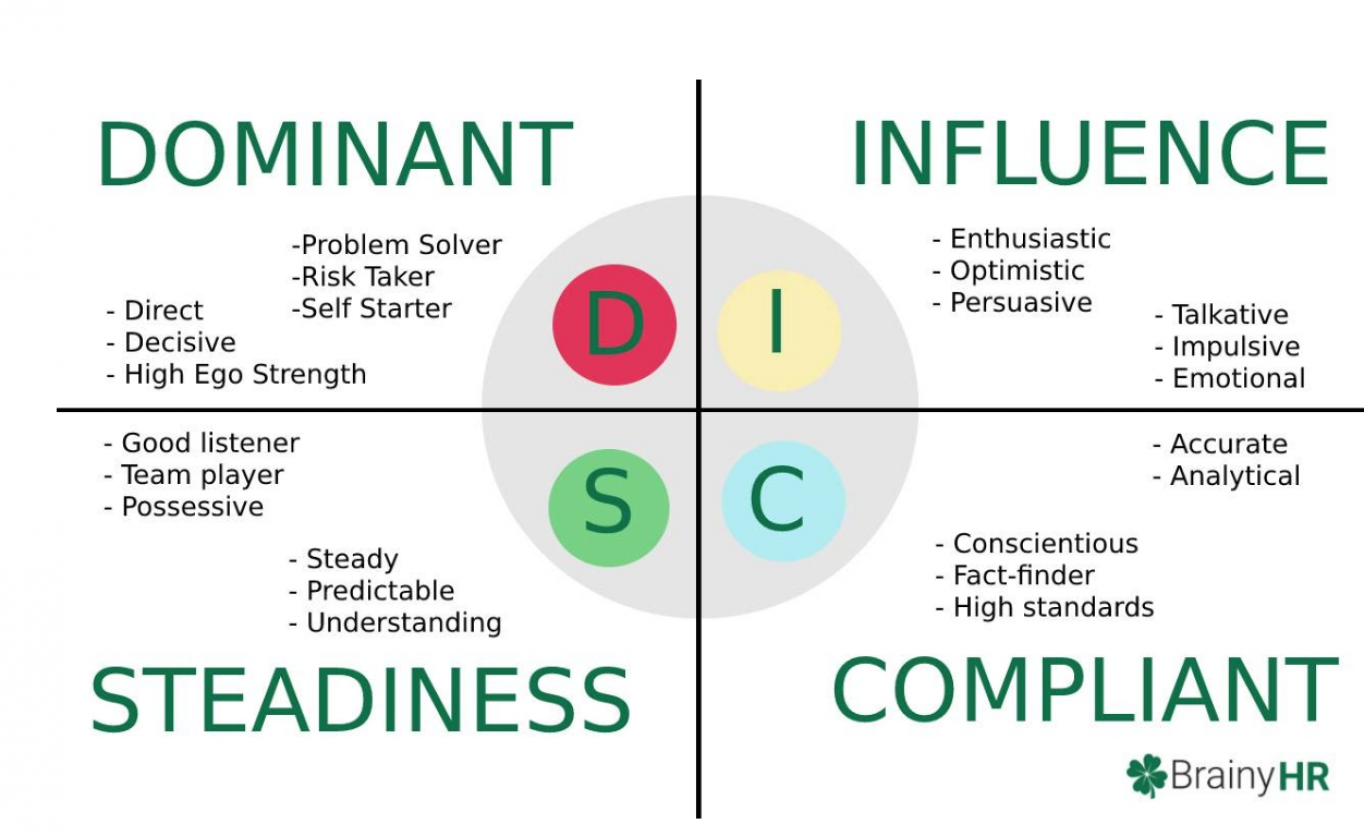Do you know that? With some people, you are immediately on the same wavelength when it comes to communication, while with others, you never come on a green branch. The respective DISC profile could be a reason for this. According to this, every person belongs to one of the four necessary DISC types, which influences how we work and communicate. The advantage is that those who know their own and their counterparts DISC profiles can use this profitably for themselves.

DISC model
Behavioral analysis of DISC uses a four-zone model of human behavior commonly known as DISC as a theoretical basis. The model doesn't classify people as good or bad. It also does not limit the development of an individual in any direction or work environment. This theory describes the natural way of reacting in various situations, e.g., communication style and making decisions.
The analyses may describe, among other things, natural style of behavior, communication style, way of making decisions, strengths, what motivates and what demotivates a given person and indicates potential areas for work on oneself. This information is presented in a way that allows you to use it to increase the effectiveness of your operations.
Individual Analysis is a self-assessment. What distinguishes Individual Analysis from other assessment tools is that it measures the unconscious level of behavior more deeply to counteract the external environment’s influence. In practice, this means that the results show who the respondent is, not what he thinks he should be in the current work environment. As a result, the report identifies real strengths and potential areas for improvement, allowing for more effective operation.
The training is dedicated to middle and senior managers who want to improve their team management competencies. The training will allow you to acquire practical team management skills, thus achieving the set company goals.
The DISC model works with the participants' self-description. There are four different personality types, or DISC profiles, that give the model its name.
D: The dominant type
This category includes people who have no problem making decisions - even if they are uncomfortable. When these people have made a decision, they implement it quickly and without much hesitation. Those around them perceive people who belong to the dominant type as very determined because they like to take control. Sometimes their dominant nature can even be perceived as aggressive and reckless.
I: The initiative type
Ideas and new situations easily inspire people who belong to the initiative type. The social component - and especially the interaction with others - is the focus of these people. Initiative types, therefore, particularly enjoy working in teams with others. You like to communicate a lot. As a result, smaller details are quickly lost sight of. The initiative type is characterized by a more associative and creative working style. For more structured and orderly types, this working style can sometimes appear messy or even irritating.
S: The steady type
The steady types strive for balance and harmony. Conversely, this also means that these people have a very pronounced need for connection. This can lead to problems in the professional environment, especially when steady types are supposed to take on management responsibility. Instead of making uncomfortable decisions, they look for an acceptable solution for everyone involved. The regular type is more conservative and usually has to struggle with new situations and changes. This guy prefers to hold back and work in the background.
G: The conscientious guy
Conscientious types attach great importance to accuracy and transparent structures. The working style of this type is characterized by logically shaped thinking and highly systematic. Besides, this type has high demands on quality - both for their work and others’ work. It also has an impact on interpersonal relationships. More creative types have problems with this way of thinking and communicating. The highly logical thinking of these people makes them seem aloof and sometimes hostile.
The DISC test
The DISC test is a so-called personality test. It means that the test only tells you which type predominates in you. However, there is no comparison with other people. So after the test you don't know whether you are more conscientious than Mr or Mrs ABC, for example.
There are various pages on the Internet on which you can be assigned to one of the four DISC profiles after answering a few questions. The tests of the various providers are similar in structure.
Based on various adjectives, which are given as possible answers, the people should place themselves on a scale. Using this scale, the person is assigned to one of the four basic types.
Beginners in the field of personality tests, in particular, should be careful with this. If you are inexperienced in evaluating, you could be quick to draw the wrong conclusions.
If you only use the DISC model for private purposes, it doesn't matter. However, as an inexperienced beginner, use the model to decide on the weal and woe of new or existing employees, which can become problematic.
Therefore, if you want to use the DISC test in a professional environment, you should familiarize yourself with the topic and seek advice from a professional. You should not only use the DISC test, but fundamentally no personality tests without professional support in a professional context. However, if you have a reliable partner at your side and have familiarized yourself with the topic, nothing speaks against using the DISC test.



 Posted on Feb 4, 2021 by Anna
Posted on Feb 4, 2021 by Anna


